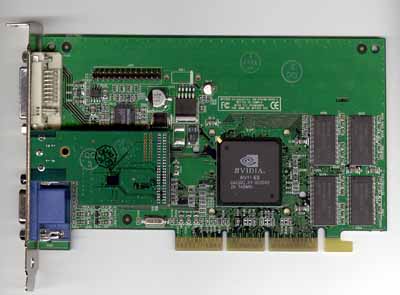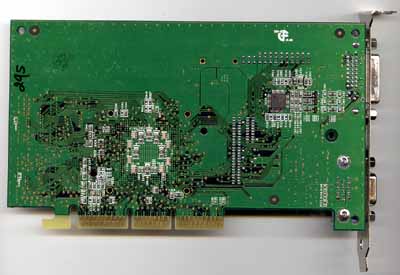Budget Video Card Comparison - November 2000
by Matthew Witheiler on November 27, 2000 3:20 AM EST- Posted in
- GPUs
The memory bus controlled the GeForce2 MX is rather unique. As opposed to most cards out there, the GeForce2 MX is able to accommodate two different memory bus lengths: a 64-bit SDR/DDR bus and a 128-bit SDR bus. This means that manufacturers of GeForce2 MX based cards have a choice. They can use the standard SDR memory on the 128-bit bus or they can choose to use DDR memory on the 64-bit memory bus. It is this property of the GeForce2 MX that has led to quite a bit of confusion regarding MX based cards.
The vast majority of GeForce2 MX cards out there use the standard 128-bit memory bus coupled with SDR memory clocked at 166 MHz to provide 2.7 GB/s of memory bandwidth. This is essentially the same memory bus used by both the Radeon SDR as well as the Voodoo4 4500. Creative Labs, however, got quite some attention when they announced that they would be producing a "DDR GeForce2 MX." For many users, the letters DDR equate to higher performance, as the DDR memory can transfer twice as much data per clock over SDR memory. Therefore, quite a good number of users out there were ecstatic to hear of a DDR GeForce2 MX card, thinking that it would bring the MX up to the levels of many GTS cards. The fact of the matter is that this would be true, if it were not for the fact that all DDR GeForce2 MX based cards use the narrower 64-bit memory bus, steering NVIDIA clear from any internal competition.
By halving the memory bus width and doubling the amount of data that can travel along this bus in a cycle, the 64-bit DDR GeForce2 MX based cards should end up performing identical to the 128-bit SDR MX cards. Indeed, both types of cards feature the same memory bandwidth of 2.7 GB/s. The truth of the matter is that we may see the 128-bit SDR cards performing slightly faster than the 64-bit DDR cards due to the fact that SDR memory is theoretically more efficient than DDR memory.
So why use a 64-bit DDR configuration in a GeForce2 MX based product. Well, first off, this setup may prove to be slightly cheaper to produce when compared to the 128-bit SDR cards. It is true that DDR memory is more pricey than SDR memory, however the money spent using DDR memory is money saved when producing only a 64-bit wide memory bus. Since the smaller the width of the memory bus, the less internal traces are necessary in the board, production costs are decreased. The second reason for using DDR memory its marketing value. As we mentioned above, users who see the letters DDR equate this to higher performance. If two cards were placed on a store shelf next to one another, one boasting DDR memory and the other using SDR memory, the vast majority of users would pick the "faster" DDR product giving the two are the same price. Judging by the number of e-mails we get regarding the "DDR GeForce2 MX" cards, it seems that this marketing strategy is working. Even examining Creative Labs' website brings no mention of the narrower 64-bit bus, only the key phrase "DDR" all over the page, leading the uninformed consumer to believe that the DDR card is faster. Whether or not it was Creative Labs' desire to mislead consumers can not be know, but rest assured that not only this "DDR GeForce2 MX" card, but all others taunting the same name will contain the sub par 64-bit memory bus.
Regardless of the type of memory bus used, GeForce2 MX based cards are quite powerful. Featuring a fill rate 220 million texels per second faster than NVIDIA's previous top performer, the GeForce 256, the GeForce2 MX core is not just a rehashed old processor. By including features not found on any other NVIDIA product, the MX may just find its way into non-buget systems as well.












0 Comments
View All Comments